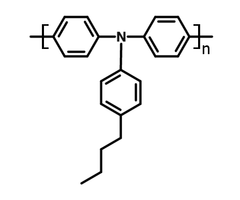PolyTPD
CAS Number 472960-35-3
Interface Polymers, Materials, OFET & OLED Polymer Materials, Perovskite Interface Materials,PolyTPD, excellent HTL material for photovoltaics
High quality polymer available with free shipping on qualifying orders
Specifications | MSDS | Literature and Reviews
Poly(N,N'-bis-4-butylphenyl-N,N'-bisphenyl)benzidine, also known as polyTPD or Poly-TPD (CAS number 472960-35-3), is an excellent hole transport layer material used in photovoltaics such as perovskite solar cells. It has also proven polyTPD is a promising HTL candidate in multilayer WPLEDs because its HOMO level 5.2 eV is very close to the work function of the indium tin oxide ITO/PEDOT:PSS anode.
PolyTPD from Ossila was used in the high-impact paper (IF 13.281), Self-Powered Low-Cost UVC Sensor Based on Organic-Inorganic Heterojunction for Partial Discharge Detection, T. Park et al., Small, 2100695 (2021); DOI: 10.1002/smll.202100695.
As the highest occupied molecular orbital (HOMO) of polyTPD matches well with the VB of the perovskite, which allows for a good transport of holes towards the polyTPD, it is a popular semiconducting material candidate that is used in the HTL of the perovskite structures. And also as the LUMO of polyTPD is significantly closer to vacuum compared with that of the perovskite CB, polyTPD efficiently blocks the flow of electrons [5].
Like PTAA, polyTPD is one of the family members of poly(triaryl)amines.
Luminosyn™ PolyTPD
Luminosyn™ PolyTPD is now available.
High Purity
Purified by Soxhlet extraction with methanol, hexane, and chlorobenzene under an argon atmosphere
Batch-Specific GPC data
Precise molecular weights are always available to provide a reliable reference in your thesis or publication
Large Quantity Orders
Plan and conduct your experiments
with confidence using polymers from the same batch
General Information
| CAS Number | 472960-35-3 |
|---|---|
| Chemical Formula | (C22H21N)n |
| HOMO / LUMO | HOMO 5.2 eV LUMO 2.3 eV [1] |
| Soluble in | THF, o-xylene, toluene, chloroform, chlorobenzene |
| Recommended Processing Solvents at 10mg/ml | Toluene (8mg/ml) |
| Synonyms |
Poly[N,N’-bis(4-butylphenyl)-N,N’-bisphenylbenzidine] Poly(4-butylphenyldiphenylamine) polytpd poly-tpd |
| Classification / Family | Poly(triarylamines), Organic semiconducting materials, Hole transport layer materials (HTL), Electron block layer material (EBL), Organic Photovoltaics, Polymer Solar Cells, Light-emitting Diodes, Quantun Dot Light-emitting Diodes, OFETs and Perovskite hole transport layer materials |
Batch information
| Batch number | MW | Mn | PDI | Stock info |
|---|---|---|---|---|
| M0521A5 | 63,630 | 11,915 | 5.34 | In stock |
Chemical Structure

Device Structure(s)
| Device Structure | ITO/PEDOT:PSS/PVK:polyTPD (1:1 wt%) 50 nm/PFO:MEH-PPV*(95.5:0.5 wt%) 70 nm/Ca/Al [4] |
|---|---|
| Color |
|
| Max. Luminance | ~ 5,000 cd/m2 |
| Max. Current Efficiency | 3.15 cd/A |
| Device Structure | ITO/P(VDF-TrFE-CFE) (1000 nm)/poly-TPD:F4TCNQ (7%, 70 nm)/ PVK:OXD-7:Ir(ppy)3 (150 nm)/TmPyPB(40 nm)/LiF(1 nm)/Al(150 nm) [7] |
|---|---|
| Color |
|
| Max. Luminance | 13,800 cd/m2 |
| Max. Current Efficiency | 76.2 cd/A |
| Max. Power Efficiency | 17.1 lm W−1 |
| Device Structure | ITO/PEDOT:PSS(30 nm)/poly-TPD(40 nm)/DNA-CTMA*(20 nm)/PFO:MEH-PPV (70 nm)/Cs2CO3(1 – 2 nm)/Al [2] |
|---|---|
| Color |
|
| Max. Luminance | 10,500 cd/m2 |
| Max. Current Efficiency | 10 cd/A |
*For chemical structure informations please refer to the cited references
| Device Structure | ITO/polyTPD/CH3NH3PbI3/PCBM/C60/BCP/Ag [6] | ITO/PEDOT:PSS/CH3NH3PbI3/PCBM/C60/BCP/Ag [6] |
|---|---|---|
| JSC (mA cm-2) | 22.0 | 11.3 |
| VOC (V) | 1.0 (1.1a) | 0.79 |
| FF (%) | 69.7 | 62.7 |
| PCE (best) | 15.3 | 5.58 |
PolyTPD as a HTL to compare with PEDOT:PSS a) 1.0 V in the supporting information and 1.1 V in the body text of the cited lit. [6]
MSDS Documentation
Literature and Reviews
- Bright, multicolored light-emitting diodes based on quantum dots, Q. Sun et al., Nat. Photonics, 1, 717 - 722 (2007); doi:10.1038/nphoton.2007.226.
- Multilayer white polymer light-emitting diodes with deoxyribonucleic acid-cetyltrimetylammonium complex as a hole-transporting/electronblocking layer, Q. Sun et al., Appl. Phys. Lett., 92, 251108 (2008); doi: 10.1063/1.2948864.
- Electro-optics of perovskite solar cells, Q. Lin et al., Nat. Photonics, 9, 106–112 (2015); doi:10.1038/nphoton.2014.284.
